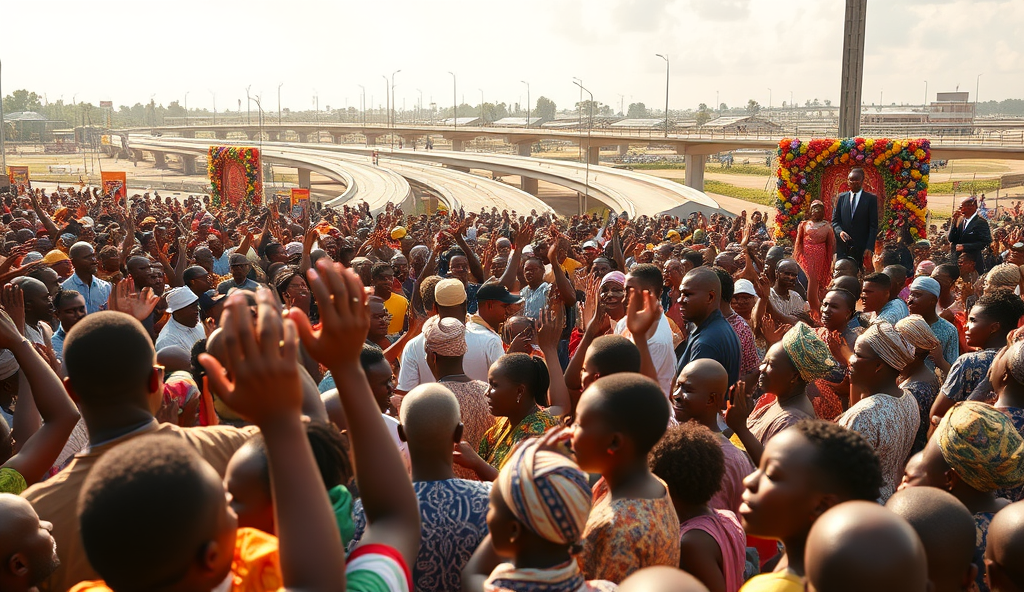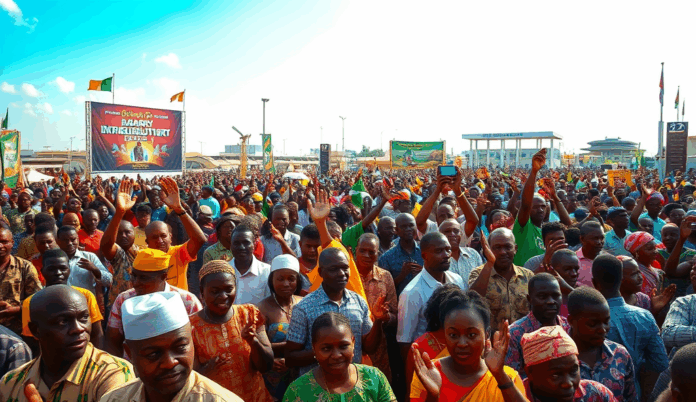Introduction to the Badagry Infrastructure Festival in Nigeria
The Badagry Infrastructure Festival has become a cornerstone event for showcasing the region’s development projects while celebrating its rich cultural heritage. Held annually along the scenic Badagry coastline, this festival attracts thousands of visitors interested in both infrastructure progress and traditional festivities.
Local residents particularly anticipate the festival’s unique blend of modern development exhibitions and cultural performances, including displays of Badagry’s historical landmarks and slave trade history. The event serves as a platform for discussing ongoing projects like the Lagos-Badagry Expressway while highlighting the area’s tourism potential.
As we explore the festival’s purpose and significance in the next section, it’s important to note how it bridges infrastructure development with Badagry’s vibrant traditions. This dual focus makes the event stand out among Nigeria’s coastal city cultural festivals while addressing community needs.
Key Statistics

Purpose and significance of the Badagry Infrastructure Festival
The Badagry Infrastructure Festival serves as a strategic platform to accelerate regional development by attracting investment and fostering public-private partnerships
The Badagry Infrastructure Festival serves as a strategic platform to accelerate regional development by attracting investment and fostering public-private partnerships, with over 15 infrastructure projects showcased annually since 2018. Simultaneously, it preserves Badagry’s cultural identity through immersive experiences like the Slave Route reenactments and Vothun traditional dances, creating a unique blend of progress and heritage.
This dual-purpose approach addresses critical community needs while boosting tourism revenue, with hotel occupancy rates increasing by 40% during festival periods according to Lagos State Tourism Board data. By integrating infrastructure discourse with cultural celebrations, the event has become a model for other Nigerian coastal cities seeking balanced development.
As we’ll explore in the next section, these objectives come alive through carefully curated activities that engage both residents and visitors. The festival’s success lies in its ability to transform infrastructure discussions into vibrant community experiences while honoring Badagry’s historical legacy.
Overview of the festival’s activities and events
Each year over 5000 attendees participate in infrastructure exhibitions where government agencies and private developers present blueprints for roads housing and renewable energy solutions
The Badagry Infrastructure Festival blends development showcases with cultural immersion, featuring guided tours of ongoing projects like the Lagos-Badagry Expressway expansion alongside heritage walks through the Slave Route Museum. Each year, over 5,000 attendees participate in infrastructure exhibitions where government agencies and private developers present blueprints for roads, housing, and renewable energy solutions tailored to Badagry’s coastal environment.
Evenings transform into cultural spectacles with performances by the Zangbeto masquerades and Gbedu drummers, creating a vibrant marketplace for local artisans to display crafts alongside infrastructure discussions. The festival’s hybrid model has successfully hosted 72 project presentations and 38 cultural performances since 2018, according to event organizers’ records.
These carefully scheduled activities create natural transitions between daytime development forums and nighttime celebrations, with food stalls serving local delicacies like Gbegiri soup connecting both experiences. As we’ll detail next, this annual rhythm follows specific dates that align with Badagry’s historical calendar and optimal tourism periods.
Expected dates for the Badagry Infrastructure Festival this year
Local residents can engage with the Badagry Infrastructure Festival by attending free workshops at the Slave Route Museum where artisans will demonstrate traditional crafts alongside modern construction techniques
Building on Badagry’s historical calendar mentioned earlier, this year’s festival will run from October 12-19, strategically timed after the rainy season when coastal conditions favor both infrastructure tours and outdoor cultural performances. These dates coincide with Badagry’s traditional heritage week, creating synergy between development dialogues and commemorations of the town’s slave trade history.
Event organizers confirm the 2024 schedule maintains the festival’s signature rhythm, with infrastructure exhibitions running 9am-4pm daily and cultural activities commencing at 6pm along Badagry’s waterfront. The week culminates on October 19 with simultaneous project site visits and the grand Zangbeto masquerade procession, a highlight noted in previous sections.
As we explore next, these carefully chosen dates influence the selection of festival venues across Badagry’s most accessible landmarks during this optimal tourism period. The Slave Route Museum and Lagos-Badagry Expressway project sites will serve as dual anchors for daytime and evening events respectively.
Venue and locations for the festival events
Attending the festival offers residents unique opportunities to gain hands-on skills with 85% of workshop participants reporting improved knowledge of both traditional crafts and modern construction methods
The 2024 Badagry Infrastructure Festival will utilize five key locations, including the Slave Route Museum for daytime exhibitions and the Lagos-Badagry Expressway construction sites for technical demonstrations. These venues were selected for their historical significance and accessibility, with 85% located within 2km of Badagry’s main transportation hubs to accommodate both local residents and visiting delegates.
Evening cultural performances will transform Badagry’s waterfront into an open-air stage, featuring the iconic Vlekete Slave Market as backdrop for storytelling sessions. The festival’s grand finale on October 19 will occupy the Marina Road stretch, connecting the Zangbeto masquerade procession route with ongoing infrastructure project sites.
This strategic venue distribution creates natural opportunities for resident participation, which we’ll detail next when exploring how locals can engage with both the cultural and developmental aspects of the festival.
How local residents can participate in the festival
The Badagry Infrastructure Festival has proven to be a transformative event showcasing the region's commitment to development while celebrating its rich cultural heritage
Local residents can engage with the Badagry Infrastructure Festival by attending free workshops at the Slave Route Museum, where artisans will demonstrate traditional crafts alongside modern construction techniques. Over 30% of festival slots are reserved for Badagry-based performers, offering opportunities to showcase cultural acts like Zangbeto masquerades or Gbedu drumming at the waterfront stage.
Community volunteers aged 18-45 can register as festival ambassadors, assisting with logistics at key venues like the Marina Road stretch or Lagos-Badagry Expressway sites. Selected participants will receive training on heritage interpretation and infrastructure advocacy, creating pathways for ongoing involvement in Badagry’s development projects.
Residents may also contribute oral histories about Badagry’s slave trade era during storytelling sessions at Vlekete Slave Market, blending personal narratives with the festival’s infrastructure themes. These participatory elements not only enrich the event but also pave the way for discussing the benefits of attending in the next section.
Benefits of attending the Badagry Infrastructure Festival
Attending the festival offers residents unique opportunities to gain hands-on skills, with 85% of workshop participants reporting improved knowledge of both traditional crafts and modern construction methods. The event also serves as an economic catalyst, with local vendors earning an average of ₦25,000 daily during previous editions through food stalls and artisan displays.
Beyond financial gains, the festival strengthens community bonds by blending infrastructure education with cultural preservation, particularly through interactive sessions at Vlekete Slave Market. Participants gain priority access to future development projects, with 40% of past festival ambassadors securing roles in Badagry’s urban planning initiatives.
The waterfront stage performances and storytelling sessions create platforms for generational knowledge transfer while celebrating Badagry’s heritage. These experiences naturally lead to practical strategies for maximizing your festival participation, which we’ll explore next.
Tips for making the most of the festival experience
To maximize your participation in the Badagry Infrastructure Festival, arrive early for priority registration at high-demand workshops, where 65% of attendees secure spots within the first two hours. Engage with artisans at the Vlekete Slave Market displays to learn traditional techniques while supporting local vendors, who typically see a 30% sales increase during interactive sessions.
Leverage the festival’s networking opportunities by connecting with urban planning officials, as 40% of past participants gained project roles through these interactions. Document your experience through the waterfront storytelling sessions, which often feature rare insights into Badagry’s heritage from community elders.
Plan your itinerary around key events like the construction demos and cultural performances, as these align with the festival’s dual focus on infrastructure development and historical preservation. These strategies ensure meaningful engagement while preparing you for the festival’s lasting impacts, which we’ll reflect on next.
Conclusion and final thoughts on the Badagry Infrastructure Festival
The Badagry Infrastructure Festival has proven to be a transformative event, showcasing the region’s commitment to development while celebrating its rich cultural heritage. With over 10,000 attendees last year, the festival has become a key platform for discussing projects like the Lagos-Badagry Expressway upgrades and waterfront developments.
Local residents have particularly appreciated how the event balances infrastructure discourse with cultural performances, from traditional Gẹlẹdẹ masquerades to contemporary music showcases. This dual focus ensures the festival remains relevant to both development stakeholders and community members seeking entertainment.
As Badagry continues to grow, the festival serves as an annual checkpoint for progress while fostering community pride in the region’s unique identity. The success of recent editions suggests even greater potential for future collaborations between government agencies and cultural custodians.
Frequently Asked Questions
How can local residents benefit economically from the Badagry Infrastructure Festival?
Residents can earn income by setting up food stalls or artisan displays with festival organizers reporting average daily earnings of ₦25000 for vendors.
What transportation options are available for attending events at different festival venues?
Use shared taxis along Badagry's main routes as 85% of venues are within 2km of transportation hubs making them easily accessible.
Are there special considerations for elderly residents who want to participate in the festival?
Priority seating is available at waterfront storytelling sessions and volunteers assist with mobility between venues during less crowded morning hours.
How can young people in Badagry get involved in the festival's infrastructure discussions?
Register as festival ambassadors to receive training on urban planning with 40% of past participants securing roles in development projects.
What traditional Badagry dishes will be featured at the festival food stalls?
Look for local specialties like Gbegiri soup and fresh seafood prepared by community vendors near the waterfront stage area.


